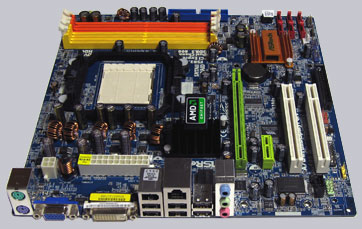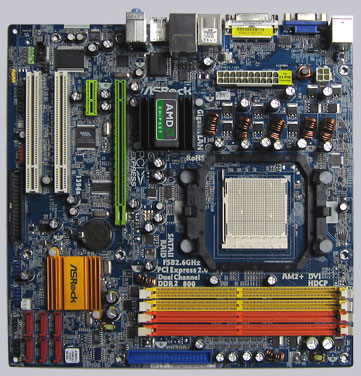
Result and general impression
+++ The ASRock A780FullDisplayPort motherboard has a price of approx. 60 Euro (05/2008) and is thus in the lower price segment of the Socket AM2 and Socket AM2+ motherboards.
The ASRock A780FullDisplayPort Socket AM2+ Micro ATX motherboard is based on the AMD 780G chipset and offers especially fantastic connection options for the graphics output. VGA, DVI-D, HDMI and also the latest DisplayPort graphics output is possible with this brand-new ASRock board. The review will show, if this reasonably priced motherboard is suitable for a HTPC living room PC and if it can be overclocked for High-End PCs and underclocked for low power consumption PCs …
Equipment and features …
The A780FullDisplayPort board offers one PCI Express 2.0 16x Slot, one PCIe 2.0 1x Slot and two PCI Slots for conventional extension cards.
The ASRock A780FullDisplayPort can be equipped with up to four DDRII memory modules and is upgradeable up to 8 GB memory. The total amount depends on the operating system used. With a Socket AM2+ K10 (AMD Phenom) CPU it supports DDR2-1066 thanks to the new K10 memory controller and with a Socket AM2 K8 (AMD Athlon 64) CPU it supports DDR2-800.
The motherboard offers one IDE connector for maximally two conventional ATA 133 drives and six SATA II ports (3 Gb/s) with RAID support. ASRock doesn’t offer eSATA II ports on this board may be for lack of space, but the S-ATA II ports supports Hot Plug and Hot Swap functions in AHCI mode. AHCI stands by the way for Advanced Host Controller Interface and has become a standard for usual control of S-ATA. The installation of Serial ATA II hard disks is described in the manual as well as all basic informations to manage a new installation of Windows XP or Windows Vista with SATA hard disks. RAID drivers for Windows XP and Windows Vista 64bit or 32bit are provided on the CDROM.
Here is a picture of the six S-ATA II ports …
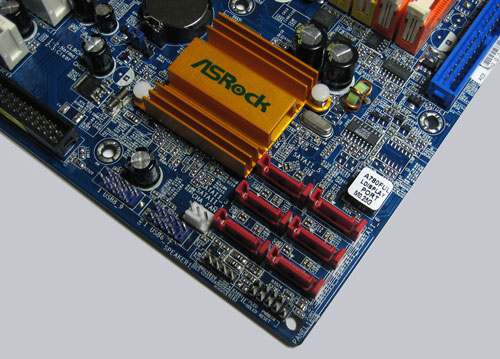
The board has six USB 2.0 ports and one IEEE1394 Firewire ports at the ATX panel, two internal USB 2.0 plugs for up to four optional USB ports and one optional internal IEEE1394a Firewire connector e.g. for chassis with front panel IEEE1394 ports. The ATX panel also provides an onboard 10/100/1000 LAN connector with WoL (Wake on Lan) and two PS/2 ports.
Unfortunately this ASRock board has no usual parallel port (LPT) at the ATX panel and just an optional serial port (COM). Who would like to use commercial LCD or G-LCD displays for a HTPC or like to use an older printer, need to buy a parallel port card and have to hope that it is supported by the respective software. The integrated Winbond W83627EHG IO Controller IC supports a parallel port, a Gameport, a MIDI port and an IrDA connector, however there’s unfortunately only one optional connection for a COM port on the A780 FullDisplayPort motherboard. If you like to use these ports, you need a very good SMD soldering equipment, a few resistor rows, capacitors and a special modified BIOS (examples and datasheet see Winbond).
Regarding the sound output ASRock has integrated the ALC662 sound chip on the A780FullDisplayPort motherboard, which “only” offers 5.1 surround sound over three 3.5mm jacks at the ATX panel. However, the sound chip is Microsoft Windows Vista Premium level compatible and offers a digital HDMI SPDIF output, which is needed for example to connect a HDMI suitable video card with the included SPDIF cable, in order to transmit the video and sound signal for HDMI equipment like e.g. LCD TV or Beamer.
We come now again to the positive characteristics of the A780FullDisplayPort motherboard, because as you can see at the following picture, the ATX panel offers some further connectors.
Here is a picture of the ATX panel with 2x PS2, 6x USB, 1x Firewire, 1x LAN, 3x sound and both a 15-pol Sub-D VGA port, as well as a DVI-D connector …
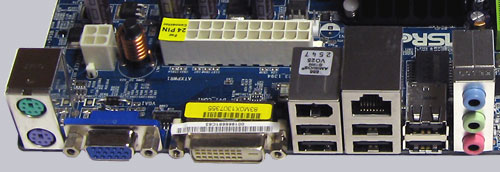
These two video outputs possibilities over VGA or DVI-D are by the way also dual monitor and Surround display suitable, thanks to the seperate signal processing. However, that’s by far not everything, what this ASRock A780FullDisplayPort board with integrated HD3200 graphics processor (short IGP) has to offer, which is based on the DirectX 10 capable RV610 chip. Because ASRock top this with some special parts, which are included in delivery. On the one hand, there is a passive DVI-D to HDMI adapter included and on the other hand, the package contains a special ASRock DisplayPort card with 1080p and HDCP support.
Here is a picture of the provided DisplayPort card for the PCIe slot …
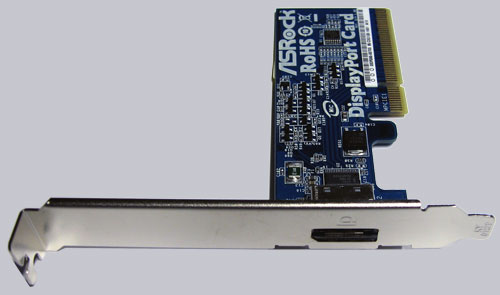
And here is a picture of the contained DVI-D to HDMI adapter …
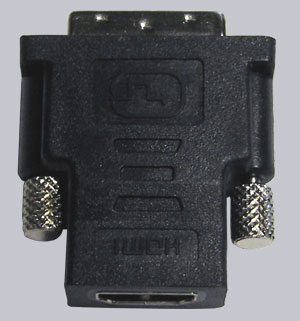
ASRock offers thus almost all most popular video output possibilities (partially combined with sound) which would be necessary to connect a current LCD monitor or LCD TV.
So the ASRock A780FullDisplayPort is not only appropriate for an inexpensive Office PC, it offers especially the very best conditions to build a uATX living room PC / HTPC (Home theatre PC). And if all other conditions are right as well, there’s no more hurdle for 1080p BD (Blu Ray Disc) playback with HDCP (Highbandwidth Digital Content Protection) coding.
Of course, all these points are interesting aspects for all home cinema friends, who like to get an inexpensive solution for a flat screen or projector at the PC without the purchase of an additional video card. Let us hope, that we soon get one standard like e.g. HDMI for the AV (Audio/Video) cable as well as the abortive HD-DVD standard …
BIOS and overclocking …
Let us go on with the BIOS options and with the BIOS overclocking or downclocking. By pressing the F2 key, you get access to the AMI BIOS with all important hardware settings.
The BIOS e.g. offers a lot of DDR2 memory settings like the memory frequency setting from 200 MHz over 266 MHz and 333 MHz on up to 400 MHz (DDR2 400/533/667/800). When using an AMD Phenom CPU (K10), it supports additionally DDR2-1066 modules as well as the so-called ganged and unganged DCTs mode for the memory addressing.
In unganged mode it has two separate 64bit DCT (DRAM Controller) which can be application-oriented much faster with two or more CPU cores. In contrast to it, single threaded applications can profit with the simple 128bit ganged mode (ganged is by the way necessary for the ECC error correction).
Once again the difference between ganged and unganged in shortform: ganged = Single Dual Channel = 1x128bit = better for single threaded applications and ECC unganged = Dual Single Channel = 2x64bit = better for multi threaded applications
The host clock is adjustable from 150 MHz up to 500 MHz and the HT (hypertransport) frequency is adjustable from 1x to 5x (200-1000 MHz). The PCIe frequency is adjustable from 75 MHz up to 200 MHz and with the asynchronous or synchronous setting of the CPU/PCIe bus, it is possible to increase the host frequence independent of the PCI and PCIe clock. Additionally, it’s possible to adjust the onBoard graphics chip with the GFXClock setting from 450MHz to 1000MHz, whereby the default frequency is 500MHz.
By asynchronous clock setting, a stable overclocking up to 290 MHz reference clock was possible. For example, the AMD Athlon64 3000+ Socket AM2 CPU with locked 9x multiplier reached nevertheless a result of approx. 2600 MHz.
An underclocking or often called downclocking of the AMD Athlon64 3000+ CPU with the lowest multiplicator of 5x and the lowest host clock of 150 MHz was possible down to approx. 754 MHz.
The BIOS offers theoretically a change of the Vcore (CPU voltage) from 0.800 V to maximally 1.550 Volt, but it is adjustable only up to the maximum Vcore of the CPU. If necessary, the Vcore can be increased with this Socket AM2 pinmod guide. Additionally, the BIOS offers a variable DDR2 memory voltage setting between 1.80 and 2.20 Volt, PCIe settings from 1.80 V to 1.90 V and a variable NBCore (chipset voltage) setting between 1.1 Volt and 1.2 Volt.
And last but not least, the A780FullDisplayPort motherboard supports an integrated “CPU Quiet Fan” option (temperature fan-control) for 4-pin CPU fans.
Result …
The ASRock A780FullDisplayPort Socket AM2+ PCIe MicroATX motherboard offers a lot of graphics outputs, a good basic equipment, as well as features for overclocking and underclocking for a low price.
Above all, the various outputs for the onBoard graphic solution of the A780FullDisplayPort board are very interesting, because this board does not only have a conventional D-Sub VGA connector, but additionally a DVI-D connector, as well as the HDMI output (over an adapter) which is important for home cinema and even the new DisplayPort is available with the ASRock DisplayPort card which is included in delivery.
But also the remaining basic equipment with six S-ATA II connectors, Gigabit LAN, up to ten USB ports and Firewire ports are quite useful. It would be nice to have 7.1 sound with six 3.5mm jacks instead of the 5.1 sound solution and a parallel port for a better downward compatibility, particularly with a small LCD for HTPCs.
Special thanks to ASRock
for their support.
**** All Socket 939 motherboard reviews since 01.11.2006 are based on an AMD Athlon 64 3000+ Orleans CPU, 1x (or SLI systems with 2x) Gigabyte GV-NX66T128VP Nvidia 6600 GT PCI Express video cards, 2x512MB Crucial Ballistix DDR2-800/PC2-6400 memory modules and the following software configuration: Microsoft Windows XP SP2, DirectX 9.0c, Forceware 81.85 video driver and 3DMark 2003. All benchmark results should only offer a comparison among themselves for a comparison.
Back to the AMD Athlon 64 and AMD Phenom Mainboard comparison !


